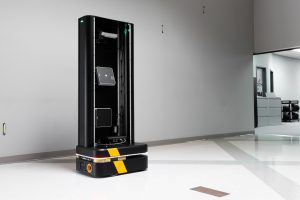The fields of artificial intelligence, automation, and robotics have seen huge growth and innovation in the last few decades. Accordingly, the future holds many exciting possibilities with the potential to fundamentally change how we work.
One specific application of autonomous robotics that will continue to see great demand is inventory management automation. With the ever-growing demands of a booming population coupled with the supply chain, ordering, and transportation issues of 2020, now more than ever, it is vital to automate inventory management in order to save time, money, increase scalability, and reduce human involvement. Ultimately, this will support the developing idea that the world’s most valuable resource will become data, and automation in the warehouse or logistics industries can do exactly that.
Enabling Logistics Oversight and Efficiency
In our second exclusive behind-the-scenes look into our custom integration projects, we wanted to introduce you to a unique Boxer application for a customer that not only has inventory and logistics centres across the United States but also around the world. Specifically, using Boxer as a base, our team created an RFID inventory scanner to assist inventory management to ultimately create better oversight and accountability for our customers.

A Radio-Frequency Identification (RFID) reader works by passing the reader close to a product in order to scan it. Using radio wave signals, the reader then picks up the RFID tag (identifier) which immediately provides the reader with the stored product information including vital details such as the expiry date, product maintenance requirements, part number, etc. This information is leveraged quickly through this technology allowing for more convenient scanning of larger product groups in even the same room or area. Ultimately, adopting RFID technology enables faster and more accurate inventory control, coupled with better inventory tracking, limited errors, and eliminating the cost and tediousness of manual record keeping.
Step 1: Identifying Customer Needs
We began our conversation with our customer for this integration project by clearly establishing the intended application for their Boxer and the need it would be filling in their warehouses. Specifically, they wanted a live view of all the in-house inventory they have to enable a searchable and accountable inventory management system. Previously, the customer had been managing their inventory through strict manual controls where a clerk would record every item that is received or removed from inventory by hand.
Naturally, this type of clerical work is time-consuming and vulnerable to human error or extenuating circumstances such as theft. Instead, the customer desired a new system where a human would receive an item, attach an RFID tag to it, scan the tag, and then enter the details of the item into their computer. Finally, the person would place the item on any shelf in their warehouse. During its warehouse rounds then, the Boxer robot would drive by and sense it with the RFID tag attached to the item. This would enable the robot to record the unique RFID tag’s number, as well as the date and time, and where exactly in the warehouse the robot sensed the RFID tag ( X, Y, Z position). Lastly, the robot would upload that data to a central database so that employees could see the live inventory levels across all their warehouses.

While the customer had laid out the general use case for Boxer and its functionality in their facilities they also had a series of specific operational requirements for the end project.
The most important operational requirements that they came to us with were the following:
- Autonomous navigation and obstacle avoidance
- Ability to scan RFID tags on shelves up to 25 feet (7.6 metres) tall
- Autonomous docking and charging capabilities
- Schedule scanning routes and shelf routines
- Data upload to the customer’s server in a .csv file format
Step 2: Assembling Required Hardware
With these requirements in hand, our integration team created the desired loadout with Boxer (version 2.4) with its built-in autonomy software, a 2D Lidar, an additional computer, and a long-range RFID scanner.

This specific robot build leveraged Boxer’s built-in autonomy software which included the platform’s built-in autonomy research kit and sensors. The navigation package provides reliable point-to-point autonomous navigation in changing indoor environments with dynamic path planning, simultaneous mapping and localization (SLAM), and obstacle avoidance.
Step 3: Adapting to Challenges on the Fly
One of our integration team’s favorite aspects of working on custom engineering projects is the many challenges and unique solutions required to create such exciting robots. For the RFID inventory scanning boxer, the main experimentation risk was getting a good estimate of the RFID tag’s X, Y, Z position. Boxer is able to indicate in which X, Y, Ø ( heading ) position it is in the warehouse which we pull from its autonomy software. We then take that data and estimate the RFID tag’s location, based on how strong of a signal we are getting from the three SICK sensors on the robot. Such precision is possible as the sensors are equipped at different angles with different power levels. As well, the sensors were specifically tuned with these angles and power levels so we can make estimates of the RFID tag locations, from ground level up to 7.6 metres high.

As well, Boxer’s web user interface allows the customer to map their facility and then set endpoints where the Boxer will travel to. A typical Boxer has endpoint options like “go-to destination”, “dock with charger”, “go park”, etc. Our software team added custom endpoints that our customers can select such as “turn on RFID scanner” or “turn off RFID scanner”. To learn more about Boxer, visit our website here.
To learn more about custom robot engineering services, visit our website here.

